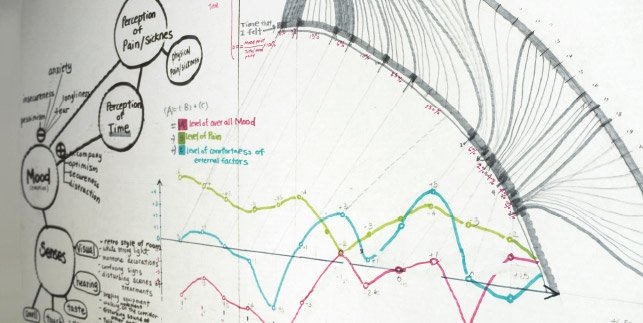Zentralinstitut der Humboldt-Universität zu Berlin

Health & Gestaltung
Re-Inventing the Patient
»Re-Inventing the Patient« is an interdisciplinary, international research programme by the project »Health & Gestaltung« and its collaboration partners. It examines the current influencing factors and design parameters in the treatment of patients inside and outside the hospital: researchers from medicine, architecture, design, game studies, computer science, ethnology and cultural studies are involved in analysing the design of clinical treatment processes, spaces and very real objects (including the hospital bed, patient files and consent forms). In which contexts did they emerge historically, and where can problems be found today? We view the research process itself as a design process – our work involves an interactive collaboration of different disciplines from which new strategies are developed. Within an innovative framework of processes, spaces and objects, these strategies can lead to long-term changes in the role and involvement of the patient at their centre.
The treatment of chronically ill patients both in the hospital and outside is currently facing many new challenges – and opportunities. Coordinating treatment processes between the medical facilities and actively involving patients in the cycle of institutions, test results, medical knowledge and treatment strategies have a direct impact on the joint, optimal design of the treatment situation (in which the keywords are »compliance« or »shared decision-making«).
Navigating Patients
In a collaboration between researchers from medicine, cultural studies and design and the project gamelab.berlin, a tablet-based application (»CarePad«) is being designed. For the first time, it brings together, connects and personalises crucial building blocks in patient-oriented data management (appointment planning, patient diary, database of diagnostic findings, background information, consent forms, treatment pathway) and makes them constantly available to the patient. Our work systematically questions the limits of conventional patient files within clinical information systems and the now increasingly available self-monitoring applications on smartphones and tablets. In tandem with this research, we will from the outset test and evaluate quickly realisable opportunities for improvement in the treatment process of chronically ill patients. In a further step, we plan to integrate the clinically oriented project »The Patient Navigation«, which researchers are working on in parallel to our project, in a joint application environment in collaboration with researchers from architecture and geoinformatics.
The Hospital Bed
The hospital bed is more than just the place where the patient stays and his or her private space. It is a gateway and interface in hospital treatment: it is where doctors, managers, health insurance representatives and other individuals encounter the clinical case. We examine the material and immaterial infrastructure of the hospital as a team of researchers from design, ethnology and cultural studies. This cultural anthropological approach opens up our analysis to meanings that may currently be invisible, yet they have a fundamental controlling function in hospital processes. Our team is designing a geography of the hospital based on the hospital bed and its historical and anthropological/symbolic meanings in the context of social spatial allocations and practices in treatment and management. Based on this research, we will develop a treatment scenario as an alternative to lying in bed, tied to a particular ward, in which the roles assigned to the bed are removed and the bed is set free for patients.
The Space of Illness
This research project is a collaboration between architecture, cultural studies and medicine, and sees urban space as an agent in medical treatment procedures. We examine different urbanisation processes and their effects on city dwellers, Homo urbanus, and the medical treatment structures available to them. Based on five spatial concepts, we will contextualise the hospital as the locus of clinical medicine within an urbanisation process. The hospital itself faces a process of continual specialisation within clinical medicine. We will describe the principle of this clinical specialisation and its spatial effects based on the example of the Charité Hospital in Berlin, which will then provide the basis for a closer analysis of the agents in the space as part of a future postdoc research project.
